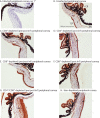Both CD8+ and CD4+ T Cells Contribute to Corneal Clouding and Viral Clearance following Vaccinia Virus Infection in C57BL/6 Mice
- PMID: 27170749
- PMCID: PMC4936152
- DOI: 10.1128/JVI.00570-16
Both CD8+ and CD4+ T Cells Contribute to Corneal Clouding and Viral Clearance following Vaccinia Virus Infection in C57BL/6 Mice
Abstract
Vaccinia virus (VACV) keratitis is a serious complication following smallpox vaccination and can lead to blindness. The pathological mechanisms involved in ocular VACV infection are poorly understood. Previous studies have used rabbits, but the lack of immune reagents and transgenic or knockout animals makes them less suitable for mechanistic studies. We report that infection of C57BL/6 mice with 1 × 10(7) PFU of vaccinia virus strain WR results in blepharitis, corneal neovascularization, and stromal keratitis. The DryVax strain of VACV was completely attenuated. Infection required corneal scarification and replication-competent virus, and the severity of ocular disease was similar in 4- to 6-week-old and 1-year-old mice. Viral titers peaked at approximately 1 × 10(6) PFU on day 5 postinfection, and virus had not cleared by day 13 postinfection. Neutrophils were found in the peripheral cornea on day 1 after infection and then declined, followed by infiltration of both CD4(+) and CD8(+) T cells, which remained peripheral throughout the infection. Blood vessel growth extended 2 to 5 mm into the cornea from the limbus. Infection of CD4(-/-), CD8(-/-), or antibody-depleted mice resulted in similar disease severity and corneal clouding, indicating that both T-cell subsets were involved in the immunopathological response. Depletion of both CD4(+) and CD8(+) T cells resulted in significantly more severe disease and failure to clear the virus. On the basis of our results, the pathology of VACV keratitis is significantly different from that of herpes simplex virus keratitis. Further studies are likely to reveal novel information regarding virulence and immune responses to viral ocular infection.
Importance: Potentially blinding eye infections can occur after vaccination for smallpox. Very little is known about the pathological mechanisms that are involved, and the information that is available was generated using rabbit models. The lack of immunological reagents for rabbits makes such studies difficult. We characterized a mouse model of vaccinia virus ocular disease using C57BL/6 mice and strain WR and show that both CD4(+) and CD8(+) T-cell subsets play a role in the blinding eye disease and in controlling virus replication. On the basis of these results, vaccinia virus keratitis is significantly different from herpes simplex virus keratitis, and further studies using this model should generate novel insights into immunopathological responses to viral ocular infection.
Copyright © 2016, American Society for Microbiology. All Rights Reserved.
Figures













References
-
- Fenner F, Henderson DA, Arita I, Jezek Z, Ladnyi ID. 1988. Smallpox and its eradication. World Health Organization, Geneva, Switzerland.
-
- Ruben FL, Lane JM. 1970. Ocular vaccinia. An epidemiologic analysis of 348 cases. Arch Ophthalmol 84:45–48. - PubMed
Publication types
MeSH terms
Grants and funding
LinkOut - more resources
Full Text Sources
Other Literature Sources
Medical
Research Materials

